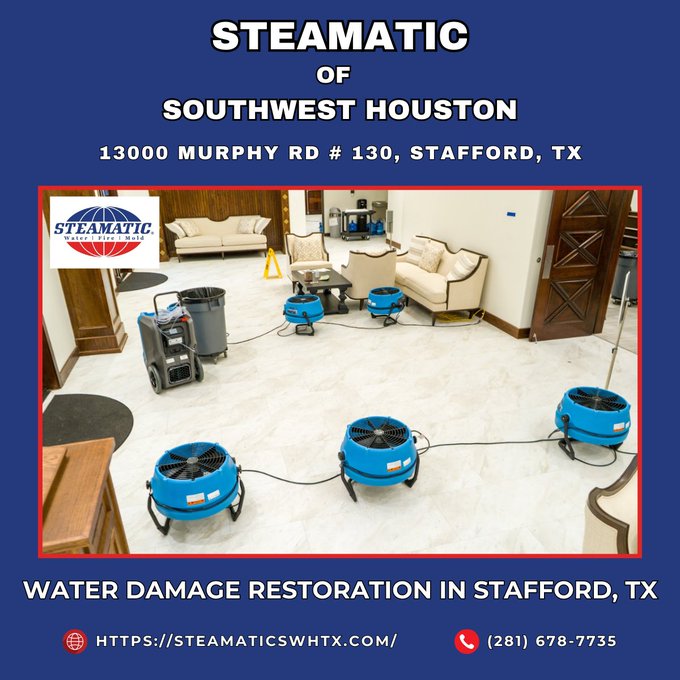Introduction
Water damage is a homeowner's worst nightmare. From unsightly stains to structural integrity concerns, the implications of water damage can be severe and costly. Whether it’s a burst pipe, flooding from a storm, or even a slow leak, knowing how to handle water-damaged floors is crucial for maintaining the value and safety of your property. This article explores various aspects of repairing Water restoration Stafford water-damaged floors, including costs, restoration processes, and tips for preventing further issues.
Repairing Water-Damaged Floors: What’s the Price Tag?
When we talk about repairing water-damaged floors, understanding the price tag is essential. But what does that actually include? First, let’s break down some common scenarios involving water-damaged floors.
Understanding Water Damage
What Causes Water Damage to Floors?
Water damage can stem from numerous sources. Common culprits include:
- Burst pipes: Sudden breaks in plumbing can flood areas quickly. Natural disasters: Heavy rains or storms often lead to flooding. Appliance leaks: Dishwashers or refrigerators with faulty hoses may drip unnoticed. Humidity: High levels of moisture over time can warp flooring materials.
Assessing the Damage
How Do You Identify Water Damage?
Identifying water damage isn't always straightforward. Here are some signs to Water damage look out for:
Discoloration: Yellow or brown stains on floors indicate moisture presence. Warping: Wood floors may buckle or swell due to prolonged exposure. Mold Growth: Fungi love damp conditions; visible mold spots are a clear sign of trouble.Costs Involved in Repairing Water-Damaged Floors
How Much Does It Cost to Repair a Water-Damaged Floor?
The cost of repairing water-damaged floors varies widely based on factors such as:
- The extent of damage Type of flooring material (hardwood, laminate, tiles) Labor costs in your area
On average, homeowners can expect to pay between $1,000 and $5,000 for repair services depending on these factors.
What Is the Restoration Cost?
Restoration costs typically involve both labor and materials needed to restore your home to its pre-damage condition. On average, restoration costs range from $15 to $40 per square foot depending on severity and type of service required.
Restoration Process Explained
Steps Involved in Floor Restoration After Water Damage
The restoration process generally involves several key steps:
Assessment: Professionals inspect and evaluate damage extent. Water Extraction: Specialized equipment like wet vacuums is used to remove standing water. Drying and Dehumidification: Air movers and dehumidifiers are employed to dry out affected areas. Cleaning and Sanitizing: Surfaces are treated with antimicrobial solutions. Repairs and Replacements: Damaged flooring materials are either repaired or replaced.DIY vs Professional Help
Should I Attempt DIY Repairs?
While some homeowners might consider tackling repairs themselves, it's crucial to weigh the pros and cons:
Pros:
- Potential cost savings A sense of accomplishment
Cons:
- Risk of improper repairs leading to future issues Lack of necessary tools or expertise
It's often recommended that significant water damage be dealt with by professionals who have experience in restoration practices.
Insurance Considerations
Is Water Damage Covered by Home Insurance?
Many homeowners wonder whether their insurance covers water damage repairs. The answer often depends on the cause:
- Sudden incidents (like burst pipes) are usually covered. Gradual damage (like leaks) may not be covered under standard policies.
Always read through your policy or consult your insurance agent for clarity.
" width="560" height="315" frameborder="0" allowfullscreen>
Prevention Measures
How Can I Prevent Future Water Damage?
Taking proactive steps can save you time and money in the long run:
Regularly check pipes for leaks. Maintain gutters and drainage systems. Invest in quality waterproof materials for basements and crawlspaces.Frequently Asked Questions (FAQs)
1. Can water-damaged wood floors be saved?
Yes, if addressed promptly using drying techniques like air movers; however, severe cases may require replacement.
2. How long does it take for water to damage a floor?
Damage can begin within hours after exposure; quick action is crucial!
3. What happens if water gets under your house?
It can lead to structural issues or mold growth if not addressed quickly.
4. How do you fix walls with water damage?
Typically involves drying out the area followed by patching up any damaged drywall with new material.
5. When should subfloor replacement occur after water damage?
If it shows signs of rot or instability during assessment—prompt action is necessary!
6. Is starting a restoration business worth it?
Absolutely! Given increasing natural disasters leading to high demand for repair services—it's potentially lucrative!
Conclusion
Repairing water-damaged floors necessitates swift action combined with informed decision-making regarding costs and methods involved in restoration efforts. Whether you choose DIY fixes or professional help—understanding what you're up against will better prepare you for potential challenges ahead while ensuring that your home's value remains intact!
Tackling issues sooner rather than later not only saves money but also prevents larger headaches down the road—so don’t wait until it’s too late! With this guide in hand about "Repairing Water-Damaged Floors: What’s the Price Tag?" you'll feel empowered when navigating these murky waters!

